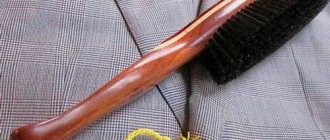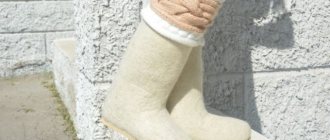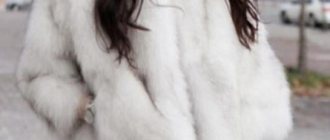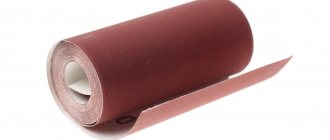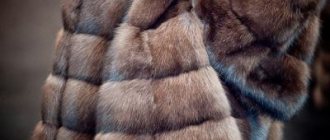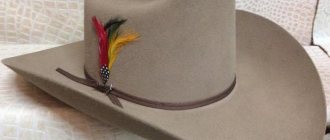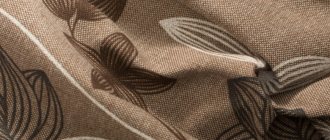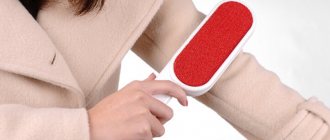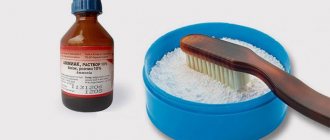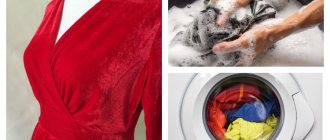Wool
It is recommended to process such items using dry methods. But some things can be washed. But still, before choosing, you need to read the label.
How to clean a wool coat at home:
- Use a sticky roller. It can be purchased in the hardware department of almost any store. The sticky roller collects all the hair, threads and lint.
- Soap solution. How to clean a coat: rub laundry soap and dilute it in a small amount of water to make a concentrated solution. Apply the composition to the contaminated area, do not rub, just leave for 10 minutes. Then rinse with a clean sponge, slightly damp.
- The greasy collar, sleeves and area around the pockets are treated with a solution of ammonia and salt. The components are mixed in a plastic container in a ratio of 1:4. The greasy areas are wiped with the prepared mixture, wait 2–5 minutes and remove the residue with a brush.
When cleaning woolen items with such mixtures, you first need to test their effect on an inconspicuous area of the item.
How to wash a wool coat? This fabric is known for its durability and strength. It insulates well in the winter, but also gets dirty quickly.
Sometimes outerwear not only needs to be cleaned of stains, but also the coat needs to be washed in a washing machine or by hand.
Is it possible to wash a wool coat in a machine? This procedure is allowed by some manufacturers, but the rules must be followed.
How to wash a wool coat in a washing machine:
- It is necessary to use detergents intended for this material. They are poured into the powder compartment after placing the product in the drum.
- Then choose a mode - manual, delicate or wool.
- After which you should set the temperature to no more than 40 degrees.
- You cannot dry or wring out such a product in a machine. While the items are being washed, prepare a drying area. This thing is placed on a horizontal surface.
Washing a coat in the washing machine is not difficult, especially if you do it in a washing machine. The main thing is to set the correct washing mode and temperature.
How to wash a wool coat by hand? First you need to clean the product from dirt and stuck hair. Use a brush or a sticky roller for this. Then fill the bath with water and add 30 ml of wool or cashmere detergent. Whip it into a foam and immerse your clothes in the liquid. Soak the item for half an hour to prevent shrinkage. Then wash the product.
How to wash a wool coat? Don't rub too hard. You can go over the clothes with a brush and gently rub them with your fingers. Then rinse the clothes in clean water and repeat the procedure if necessary.
It is important to know how to care for your coat. Proper care will keep your clothes looking good
Budget-friendly and effective home remedies will always help get rid of stains, but there is always a chance that the product may deteriorate afterwards. Therefore, if you don’t know how to wash a coat in a washing machine or are afraid to resort to such a procedure, remember that you can always use dry cleaning services.
When should you go to the dry cleaner?
A quick and easy option to return your outerwear to a fresh and presentable look is to have it dry cleaned. The hands of specialists are more reliable and effective than many home methods. In addition, the craftsmen are responsible for your clothes, so it is in their interests to do the job well.
To give your coat for cleaning:
- When the time comes. As a rule, the label indicates the optimal time that you can wear the product, and then it is advisable to refresh your favorite item.
- Light-colored clothes should be cleaned 3 times more often than dark ones. Stains, dust, and dirt settle faster on white fabrics, so the lucky owners of such items will have to visit dry cleaning regularly.
- When hard-to-remove stains have settled on clothing: oil, fuel oil, nail polish, food stains or similar.
- If the product is very expensive, it is better to play it safe and give the item to an experienced specialist. The same applies to situations when you are not confident in your own abilities.
In other cases, there is no need to seek professional help. Read below to learn how to clean your coat at home.
How to remove a greasy stain from a down jacket?
First of all, you should get rid of grease and oil stains. Over hundreds of years, a huge number of ways have appeared to remove such pollution without leaving any residue or consequences for the fabric. Here are some of them.
Salt, starch or flour
When you need to remove a fresh greasy stain, remember the three lifesavers: salt, starch or flour. Sprinkle any of them, sparingly, onto the desired area and leave for 15-20 minutes. The bulk substance will act as an absorbent, absorbing fat. The main thing is to try to act quickly. At the very least, the contamination will disappear; at a minimum, it will be much easier to clean later.
Another option is a mixture of salt and starch. Not only suitable for fresh dirt. Mix in equal proportions, add a little water and stir. A slurry should form, similar to sour cream.
Apply a thick layer to the contaminated area and rub gently to penetrate the fibers. After 7-10 minutes you can rinse with water
Repeat if necessary.
Vinegar + salt
Using vinegar and salt, you can also clean your down jacket from greasy stains. Dissolve 2 tbsp in 0.5 liters of water. l. vinegar 9%, add 1.5 tbsp. l. salt. Stir until the ingredients are completely dissolved. Soak a cloth in the resulting solution and start rubbing. If the stain is old, you can leave a dampened cloth on it for 15 minutes. In any case, after all the manipulations, the item must be taken out into fresh air until the next day.
Dishwashing liquid
A stain on a down jacket can also be removed with ordinary dishwashing liquid. Heat 0.5 liters of water to approximately 40 °C, add 1 tbsp. l. products and mix. Dip the sponge into the solution, but do not squeeze too hard. Blot the contaminated area with it and leave for 15-20 minutes. Then rinse off with a clean sponge. Most often this is enough to remove fat. But if the dirt is persistent, repeat the steps. This method works well on shiny areas: pocket cuffs, sleeves, collars.
Shampoo or washing gel
You can clean your down jacket at home without washing using gel or shampoo. They are usually used for different types of pollution. But if the concentrate is applied to the desired area, its effect will increase. Lay the down jacket on a horizontal surface, apply the product with a sponge to the dirt. After a third of an hour, treat the area with a wet cloth.
Getting rid of stains and dirt
Dealing with stains and dirt that can easily appear on your favorite coat after, for example, a trip on public transport is not difficult. Before getting rid of dirt, it is best to place a cloth between the lining to absorb excess moisture.
- Grease stains can be removed with gasoline. Saturate the fabric with it and apply it to the wrong side. Sprinkle talcum powder on top and leave it like that for several hours.
- Coffee or tea stains can be removed using the following methods: mix ammonia and glycerin in a 2:1 ratio. If you don’t have ammonia and glycerin on hand, you can use vinegar and alcohol in equal proportions.
- A greasy collar or cuffs can be treated with a solution of ammonia and salt. It is necessary to mix the products in a ratio of 1:4, moisten a cotton pad in the solution and treat the surface of the item. Oily areas are wiped and the item is placed on hangers to dry.
- To dry the product faster, you can use an iron with a steamer.
Getting rid of stubborn stains
If, when examining the product, you notice stains that cannot be removed at home (stains from blood, ink, cosmetics, food coloring), take it to the dry cleaner. For less serious stains, try cleaning it yourself. Do not rush to spin the coat in the automatic machine, as there is a risk that it will lose its shape. It is better to follow one of the following tips for removing stains of various types at home.
- Remove grease stains with purified gasoline. Apply a cloth soaked in it on the back side, and a dry napkin on the front side.
- A fresh grease stain can be removed by applying a dry paper towel and running a warm iron over it.
- You can clean your coat from tea or coffee stains with a mixture of ammonia and glycerin (1/2).
- Hydrogen peroxide can help remove beer stains.
- Try removing difficult stains with a solution made from half a glass of cool water and a teaspoon of ammonia and detergent.
- Treat the greasy area of the collar with a cotton swab with a mixture of salt and ammonia (4/1).
- Treat the shiny area with either a mixture of vinegar and alcohol (1/1), or tea leaves (if the coat is dark). Sometimes steam treatment of the problem area helps.
- Special-purpose products will help you clean a drape coat.
How to clean
A drape coat can be cleaned using a quick dry method or a more time-consuming and labor-intensive wet method. Which one to use in a particular situation depends on the degree and nature of the contamination, as well as the availability of free time and the availability of cleaning products. Let's look at each of them in detail.
Dry cleaning
Before starting cleaning, you should prepare all the products and materials used, as well as perform a number of preliminary procedures:
- Hang the coat on hangers in a well-lit place and identify the dirtiest places on the drape material.
- Using a textile roller and a brush with natural bristles, clean its surface from wool, dust and lint.
Cleaning a drape coat with light contamination is carried out according to the following algorithm:
- Cover the contaminated area of the coat laid out on a horizontal surface evenly with dry washing powder for woolen items.
- Next, rub it over the surface with gloved hands.
- An hour later, remove the powder with a brush with elastic bristles.
- Wipe with a damp sponge and let dry.
For a white or light-colored coat, it is recommended to use the following technique:
- Cover the contaminated area with Vanish or baking soda.
- After half an hour, remove the bleach with a dry brush.
For a drape coat of black or other rich color, it is allowed to use prepared foam for cleaning carpets or air conditioners. In addition, you can use rye bread crumb by crumbling it onto the drape material and then rolling it back up.
Wet cleaning
A more effective method compared to the one discussed above is wet cleaning. However, it is recommended to use it no more than once a season. Processing instructions boil down to the following steps:
- Prepare a working solution of one of the cleaning products in warm water - for washing woolen products, laundry or liquid soap, conditioner, liquid for suede.
- Apply evenly and lightly rub the product onto the contaminated area of the coat using a cloth.
- After 30 minutes, rinse the surface with warm water and blot with moisture-absorbing material.
A hydrogen peroxide solution (1:4) can effectively get rid of grease and alcohol stains on the surface of a white and light-colored drape coat. A little product should be poured onto the contaminated area, and then quickly brushed with a rag or brush.
How to clean a drape coat
It is best to clean a drape product without using detergents, only using a dry brush, sponge or adhesive tape. But if it is impossible to remove dirt using dry methods, then the softest and most delicate cleaning agents for drape clothing should be used.
Ideally, drapery products are cleaned using dry methods.
So, for cleaning drape outerwear, the following are suitable:
- weak soap solution or soap suds;
- liquid detergent for woollens and sensitive fabrics;
- carpet or car interior cleaner;
- fabric softener.
We recommend reading: How to quickly fold a T-shirt: men's, women's and children's
It is not recommended to use bleaching, lightening and oxygen products to clean a drape coat. It is also better not to use powder products, caustic acids and chemicals with an aggressive composition.
Removing stains
Talcum powder or regular baby powder can help remove fat stains on the coat. It is scattered onto the stain, allowed to absorb the grease and cleaned off with a regular brush. Such stains can also be removed by purified gasoline, which is used to moisten a swab and wipe the stain, or a solution with glycerin. A fresh greasy stain can also be cleaned with an iron. They iron the dirt through paper napkins, which absorb the dirt.
Stains on clothes from spilled tea, beer or coffee are removed with a mixture of water and glycerin or ammonia, as well as an alcohol solution and table vinegar with water. Traces of spilled wine are removed with ordinary table salt, sprinkled generously on the stains, and washed off with water.
If you are unable to deal with complex dirt or an old stain on your coat, you should resort to dry cleaning services. Such outerwear must be stored in a special fabric cover that protects the item from dust and allows air to pass through well. If you clean your coat on time, store it correctly and remove stains, it will last 5 years or more, maintaining its visual appeal.
Polyester coat
You can restore a presentable appearance by washing your clothes by hand or by machine. But first, check for stains on your polyester coat, and if there are any, remove them:
- Stain remover (according to instructions).
- Soap for washing. Helps against dust and light dirt. Prepare a solution (as for drape), soak a cloth in it, wipe the contaminated areas on a polyester coat.
- Difficult stains are removed with a 10% borax solution. Moisten a cotton swab, wipe off the dirt, then rinse.
It is recommended to dry polyester coats away from sunlight to prevent fading.
Force majeure: how to clean fresh stains from a jacket?
No one is immune from stains, even the most tidy person. A car might splash you on the street, you might get a push on your arm in a café, or a ballpoint pen might leak in your pocket. Regular rain leaves streaks on the skin. What should you do if you get a greasy stain on a leather item, stain it with ink or blood, or splash it with street dirt?
If the product gets exposed to street dirt
It is not difficult to clean the product from dust, rain stains or dried dirt. It is enough to immediately wipe the jacket with a damp cloth and then with a dry one. However, sometimes fair skin becomes stained with street dirt, which is much more difficult to get rid of.
To clean a white leather item from dust and dirt at home, you can use:
- Laundry soap. A bar of soap is grated. Dilute 1 tablespoon of soap shavings in 1 liter of water. Wipe the contaminated area with a cotton swab dipped in soapy water. After this, wash off the soap with clean cool water and wipe the skin dry with a terry towel or napkin.
- Milk. It has a whitening effect and will help restore a dirty, dusty jacket to its original appearance. Pour a teaspoon of turpentine into 1 liter of milk and wipe the contaminated area with the liquid.
- Protein with lemon. Egg whites and lemon juice will help get rid of stains that are deeply embedded in the skin. Beat 1 white until foam forms and add 3-4 drops of lemon juice. The paste is applied to the stain and then wiped with a dry cloth.
How to get rid of greasy stains?
What to do if you get a greasy stain on your leather jacket? Several remedies for removing oil impurities from the skin at home:
- Glycerol. A soft cloth is moistened in glycerin and the greasy area is wiped with it. Glycerin dissolves fat. It also restores the original shine of the leather, so it can be used to wipe old, already cracked items.
- Ammonia. Dissolve a few drops in soapy water and rub it onto the greasy stain. Ammonia can dry out the skin, so after treatment you can lubricate the cleaned area with Vaseline.
- Liquid dishwashing detergent. The formula of such a product is just suitable for the breakdown of fats. A few drops are applied to the oily area and rubbed into the skin. After a few minutes, wash off with warm water.
How to clean blood or ink stains?
Blood stains are very difficult to wash off, so you need to get rid of them immediately after they appear. You should not try to wash off blood in hot water, this will lead to an increase in the area of contamination and fixation in the material. To wash skin stained with blood, it is recommended to use:
- Hydrogen peroxide. Using a moistened cotton swab, carefully wipe off the blood from the edge of the stain to the center. However, you should be extremely careful; hydrogen peroxide can damage the leather, so you should test its effect in advance on an inconspicuous area of the item.
- Acetylsalicylic acid. Aspirin has blood thinning properties, so it can be used to clean clothes. 1 tablet is dissolved in a quarter glass of warm water. The paste is applied to the contaminated area and left for 5–10 minutes. Then the mixture is removed with a dry cloth or rag.
What should you do if your ballpoint pen runs and ink remains on your skin? Regular medical alcohol will help get rid of them. Apply it to a clean cotton swab and carefully wipe off the ink stain.
How to Clean a Faux Fabric Coat
Cashmere
- empty things from pockets;
- shake your coat on the balcony or street;
- determine the location of the spots;
- Clean clothes from dust and debris.
Afterwards, you can start cleaning your clothes yourself, using a method that suits the specific material.
Drape
When cleaning drape made from natural wool, it is recommended to do without washing. Prolonged contact with water causes the item to greatly decrease in size.
If you need to remove traces of dirt from the surface of a drape coat, then in such cases you can use a quick cleaning method. To clean such clothes you will need:
- Dilute a small amount of dishwashing detergent in water (until foam appears).
- Soak a sponge in the mixture and wipe the stained area.
- Leave the coat for 5-10 minutes, then wipe with a sponge soaked in water.
When rubbing away dirt, it is recommended to move from the edges to src=”https://you.cleaning/wp-content/uploads/2020/01/pravilnyy-metod-chistki-palto.jpg” class=”aligncenter” width=”700″ height =»401″[/img]
Carpet cleaner helps clean a light-colored drape coat. In this case, after treatment with a moistened sponge, the clothes should be left for half an hour, hung on hangers.
Cashmere
Cashmere is obtained from wool collected from the sides of mountain goats. This material is soft to the touch. Because of these features, cashmere has strict care requirements. Therefore, it is highly undesirable to conduct experiments with this tissue.
When cleaning products of this type, it is also necessary to take into account both the characteristics of the stain and the color of the clothing. To clean your coat collar you will need:
- Rub the stained area with a cotton swab dipped in soapy water.
- Wipe the stain with an ammonia solution.
- Remove applied products with a cloth soaked in water.
An adhesive tape that needs to be glued to the fabric and pulled sharply can help remove dirt, dust and lint from a black coat. And to restore color, it is recommended to wipe the cashmere with a cotton swab dipped in strong tea.
Tweed
Tweed is another type of fabric made from natural wool. This material has similar maintenance requirements as the previous ones.
The sleeves of clothes made from natural wool wear out quickly. A mixture of table salt and ammonia, taken in a 4:1 ratio, helps correct this defect. This composition should be applied to the abrasion and left for a minute. Then just brush off the mixture with a brush.
The following fairly effective method will help you clean a white tweed coat from stains of unknown nature:
- Add a tablespoon of cosmetic liquid soap to 0.5 cups of warm water.
- A tablespoon of ammonia is mixed in the resulting solution.
- The product is applied to contaminated areas and left for 10–15 minutes.
- The stain is wiped with a damp cloth.
If a tweed coat is heavily soiled, the item can be washed by hand at temperatures up to 30 degrees. It is not recommended to keep the product in water for a long time.
After cleaning, the coat must be hung on hangers.
The rules for cleaning coats described above also apply to clothes made from other types of wool. To remove stains and other traces of dirt, you can use any of the above methods.
To clean items made from natural wool, it is also recommended to use a cotton cloth soaked in plain water.
Leather
The skin does not tolerate prolonged contact with water and mechanical damage. It is not recommended to wrinkle this material frequently, as pronounced and irremovable defects form on the surface over time.
A leather coat must be wiped with a damp cotton cloth at regular intervals (every 1-2 weeks). This procedure helps maintain the original appearance of the material.
We invite you to familiarize yourself with Bitumen stains - methods and means by which you can remove them from the car body
Unlike other previously described materials, salt stains often form on leather coats. To remove white stains, you need to treat problem areas with a cotton pad soaked in table vinegar.
Suede
A suede coat stands out due to its large fibers, which give the garment an attractive appearance and create a soft texture. Clothes made from this material require delicate washing.
A suede coat must be periodically combed with a special brush, observing the direction of the fibers.
Clothing of this type often shows stains after rain. To clean such stains, you will need to rub the problem areas with an eraser and then with a crust of rye bread. After the procedure, the treatment area must be ironed by running the iron from the wrong side.
A polyester coat does not withstand high temperatures. Moreover, such things are able to retain their original shape for a long time and practically do not wrinkle.
A stain remover or salt can be used to remove dirt from a coat by pouring it onto the stain and waiting for half an hour. At the end of this time, the problem area must be washed with a soap solution (3 tablespoons of liquid soap per 2 liters of water).
To clean complex and stubborn stains from a polyester coat, you need to apply a 10% borax solution to the stained area, and then rub it with lemon juice. At the end of the procedure, the area is washed with a damp cloth.
Neoprene coat
Neoprene is an artificial rubber that covers clothing on both sides. This material has water-repellent and antibacterial properties. Also, neoprene does not wear out or wrinkle.
You can clean a coat made of this material in a washing machine in the “Delicate Wash” mode at a temperature of 30 degrees. It is recommended to use gel instead of powder. You need to wash your neoprene coat twice: on the outside and on the inside.
It is better to clean the coat from stains if a small part of the product is dirty, partially, because frequent washing of the coat can quickly ruin its appearance.
The shelf life of the coat is approximately five years. If you care for your coat carefully and you don’t wear your coat often, you can easily wear your coat longer.
Before you clean your coat at home, inspect the coat. Most often, this type of outerwear gets dirty on the sleeves, elbows, collar area, pockets, and in places where loops and button fasteners are located.
When using stain remover to clean coats, test the product on a piece of the item by turning the coat inside out before cleaning the coat.
You need to clean your coat from stains from the outer edge of the stain to the center of the stain. If you clean your coat from stains differently, streaks may remain.
Cleaning a coat will be effective if you place a cloth under the dirty area on the coat. Using a backing cloth will help catch any excess liquid.
To clean the coat collar, take salt and ammonia, preparing the product in a 4/1 ratio. A cotton swab soaked in the solution is used to wipe the greasy collar over the pile. This will perfectly clean your coat collar.
Another way to clean a coat from small dirt on the sleeves and collar involves using a soap solution, an iron and a cotton cloth.
Place the fabric marked in the solution over the stains on the coat. Then iron the fabric using the temperature specified for the coat. Dirt is absorbed into the fabric, leaving your coat clean.
The spots on the coat can be large. In this case, use a brush to pre-dry clean the coat.
Many may be interested in the question of how to clean a suede coat. The answer is that you can clean a suede coat with rubberized sponges or brushes.
Good luck!
- Using a soft brush and soap solution;
- Using a roller with adhesive tape;
- Using a vertical steam generator (if available);
- Armed with a vacuum cleaner with a clean attachment.
Rule No. 1. Remember, no matter what cleaning method you choose, the procedure always begins by studying the signs on the product label. About the drape fabric itself here.
Rules for washing and cleaning products made from different materials
The coat is cleaned depending on the material from which it is made. Recommendations can be found on the label, or you can use the method usual for products made from such fabric.
Wool
A woolen coat should be cleaned once every two weeks with a brush or a sticky roller to remove dust and hair; it is better to carry out a complete cleaning 1-2 times a year. Stains must be removed immediately after they appear or as soon as possible.
Polyester
The main thing to remember when washing a polyester coat is that synthetic fiber is sensitive to high temperatures. Both hand and machine washing are carried out in water no hotter than 40 degrees. It is forbidden to dry the item in an electric dryer, wring it at high speeds or twist it strongly.
Cashmere
Cashmere products prefer dry cleaning. To do this, hang the coat on hangers and remove surface fine debris and dust using a roller, a damp sponge or rubber gloves soaked in water, after which the coat is treated with powder, talcum powder or special deep cleaning products. If the appropriate recommendations are given on the label, the item is washed in a machine or by hand in warm water.
Drape
A coat made of drape cannot be washed in a machine, and by hand washing it is difficult to remove dirt efficiently. An unusual but effective way to clean upholstery is to clean it with carpet cleaner. The foamed cleaner is applied to the fabric, allowed to dry, then brushed off with a brush or removed with a vacuum cleaner. The material can also be wiped with a sponge soaked in soapy water, left to act for half an hour, and then rinsed off. The coat is left on hangers until completely dry.
Sintepon
The synthetic winterizer does not deform when wet, so the synthetic winterizer coat can be washed both manually and in an automatic machine. When washing, you must observe the temperature regime - no more than 30 degrees. It is recommended to add special washing balls to the drum, which will prevent the material from caking. Sintepon cannot be soaked or bleached; in addition, machine drying is prohibited.
Tweed
Tweed is a wool fabric, so dry cleaning is preferred for tweed coats. If washing is necessary, use water no hotter than 30 degrees, use a liquid detergent suitable for wool, and do not twist the item. Dry the product on a horizontal surface, removing excess moisture with a terry towel.
Leather
It is better not to wash a leather coat at home, as this can ruin the item. Light stains can be removed with a damp sponge. Salt stains on the skin are removed with vinegar.
Suede
Suede is a material with a pile, so to treat the surface it is better to use a special brush, observing the direction. Grease stains can be removed by sprinkling salt or starch on the stain for a couple of hours, then brush off with a brush. Wrinkles formed during storage can be easily smoothed out with steam.
Neoprene
Neoprene has dirt-repellent properties, so things made from this material are resistant to stains. If there is still a need for cleaning, the coat can be machine washed if you set the delicate wash program at 30 degrees and spin at low speed.
Holofiber
A holofiber coat can easily be washed in a machine. The water temperature should not exceed 40 degrees. Dry the product on a hanger, turning it inside out.
Camel's wool
Camel wool coats can be washed by hand or machine if the instructions on the label allow for such cleaning. For washing, it is better to use a liquid detergent that can be rinsed out of the material well, which will help avoid streaks. To dry the product, hang it on hangers to drain the water, and then lay it out horizontally until completely dry.
How to Clean a Faux Fabric Coat
It is recommended to care for outerwear, especially those made of delicate fabrics, before and after each wear. For frequent dry processing, the following are used: a roller with sticky tear-off sheets, a pellet remover, and a coat brush.
Thorough cleaning of items is carried out at the end of the season, if severe dirt and odors are detected.
How to fix these problems without asking a dry cleaner for help:
- Prepare the product for the procedure.
- Study the label to determine the type of fabric, method and cleaning product. If the composition of the material is mixed, focus on natural fibers (if any).
- Test the product you choose on an inconspicuous area of clothing.
- If the test was successful, spread out the lining and place moisture-absorbing fabric between it and the material.
- Start cleaning. To avoid streaks, clean the stain from the edges to the center.
Drape
It is better to entrust washing of products made from drape to specialists. The fabric consists of 2 rows of woolen threads, which will shrink in hot water. Cleaning a drape coat from dust at home:
- Apply surface treatment to the material with a dry, medium-hard brush, moving in the direction of the pile.
- Lay out the drape coat on a horizontal plane, sprinkle crumbled rye bread crumbs on top. Roll the crumbs until balls form (5-10 minutes), sweep off the remaining residue with a brush.
How to clean a lightly soiled drape coat at home:
- Hang the product on hangers.
- Work in the direction of the pile, first with a dry and then with a damp sponge.
- Dry in fresh air.
Methods for cleaning heavily soiled drape clothing:
- Following the instructions, add carpet cleaning liquid (not powder) or use Vanish Active Foam into water and foam. Distribute the foam, without rubbing, throughout the pile of the drape coat. Let dry and brush off any remaining residue.
- Prepare a solution from a liter of water and 1 capful of fabric softener. Saturate a sponge with it and treat the drape product. Then rinse and clean the clothes again and leave to dry.
- Lay the drape coat on a horizontal plane, sprinkle with baking soda and rub it into the fabric. After an hour, sweep away the remaining powder with a dry brush, then wipe the product with a damp sponge and let dry.
Suede
How to tidy up suede items without going to a dry cleaner:
- How to remove shine. Dissolve 1 teaspoon of soda in 1 glass of milk, moisten a sponge with the liquid, and wipe the shiny areas with it. Let the product dry, remove any remaining liquid with a sponge.
- How to clean grease stains. Sprinkle the contaminated area with starch and let it soak. Brush away any residue with a soft brush.
- How to eliminate stains. Wipe them with a paper eraser.
- How to remove creases. Hang the item on a hanger. Steam with a steam generator.
- How to clean dust from clothes. Take the coat out into the fresh air, wipe it with a sponge soaked in ammonia, and leave it to air.
- How to iron suede clothes. Iron the item from the wrong side, setting the iron to the minimum temperature.
- How to clean faux suede. Beat the foam with washing gel (1 capful per liter of water), apply to the dirty area. After 5 minutes, wipe off with a dry paper towel.
From tweed
How to clean a tweed coat at home:
- Renew greasy, worn areas with a mixture of 1 part ammonia and 4 parts salt. Mix the ingredients, spread the mixture over the problem area, and wipe off with a dry sponge after 1–2 minutes.
- Collect dust using a vacuum cleaner. Before the procedure, check that all decorative elements and buttons are well sewn.
- Clean the grease with a sponge dipped in purified gasoline. Blot the contaminated part from the inside of the coat with it, and place a piece of clean cloth made of natural fibers on the outside of the stain. Leave until the stain disappears.
- The remaining stains are made with a mixture of 1 glass of warm water, 1 tablespoon of liquid soap and the same amount of ammonia. Clean the stain first with this solution and then with a clean, damp sponge.
Made from polyester
Artificial fabrics are easy to clean and wash at home. Polyester is a synthetic material made from polyester fibers. It hardly wrinkles and holds its shape well. How to clean a polyester coat:
- Brush off the dust with a brush or dry sponge and shake the product.
- For fresh stains, apply a bleach-free stain remover (Vanish, ACE). Use the product according to the instructions, after testing it on the reverse side of the item.
- Sprinkle the greasy stain generously with salt, and after 30 minutes, use a dry sponge to remove any remaining salt.
Made from neoprene
This material is made of foam rubber, covered on both sides with elastic fabric (cotton, polyester). Neoprene products last a long time, hardly wrinkle, and do not get dirty. How to clean a neoprene coat:
- If there is dust or dirt: treat the item with a clothes brush moistened with warm water.
- If you find a greasy stain: sprinkle the contaminated area with talcum powder or soda, and after 20–30 minutes, wipe off the remaining powder with a dry sponge.
Wool coat
How to clean wool products:
- Remove dust and hair with a dry brush or roller with adhesive tape.
- Restore the shine to a dark wool coat with a sponge dipped in strong black tea.
- Treat the abrasions with a mixture of salt and ammonia (ratio 4:1), remove excess with a dry sponge.
- Blot greasy stains from the inside with a sponge soaked in purified gasoline. Apply a piece of clean cloth made from natural fibers to the stain on the outside. After the stain has disappeared, wipe the treated area of the wool coat with a damp cloth.
Cashmere
Mountain goat fluff is used to produce cashmere. The fabric is very delicate and soft; it is recommended to clean it at home very carefully. The product used must be tested on the back of the clothing. How to clean a cashmere coat at home:
- To remove dust, hang the item on hangers, wipe with a wet, well-wrung cotton cloth, and leave to dry.
- To remove traces of sweat, wipe the stain with a cotton pad soaked in a soapy solution (2 tbsp liquid soap/1 tbsp water). Then treat the stain with a sponge soaked in ammonia and wipe with a clean cloth.
- Wipe the greasy stain with a solution of dishwashing detergent (1 tbsp./1 tbsp. water), and then with a damp soft sponge. Let the cashmere coat dry.
- Treat paint and ballpoint pen stains on dark clothes with purified gasoline, and on light-colored clothes with nail polish remover. Soak a cotton pad in the substance and test its effect on an inconspicuous area. If the color of the material has not changed, apply a sponge soaked in gasoline or nail polish remover to the stain on the inside of the cashmere garment. Using blotting movements, treat the stain until it disappears.
We suggest you familiarize yourself with yellow spots on a white down jacket after washing
How to clean a leather coat without resorting to dry cleaning:
- Wipe the dusty product with a damp, clean cloth.
- Clean worn areas with a sponge moistened with alcohol. Do the same with lemon juice, and at the end wipe the fabric with glycerin.
- Remove light stains using a soap-alcohol solution. Mix 1 tbsp. water, 1 tbsp. l. ammonia and 2 tbsp. l. liquid soap. Soak a sponge in the mixture and wipe the leather coat with it. Remove any remaining product with a damp cloth.
- Clean salt stains on winter clothes with a cotton pad soaked in vinegar (9%) and then wipe with a damp sponge.
- Remove oil paint with a sponge soaked in vegetable oil.
- Use ground coffee to remove unpleasant odors. Sprinkle it on a coat laid out on a horizontal surface, leave it for a day, shake the clothes.
- To refresh and soften the material, rub dark skin 2-3 times with castor oil, taking breaks of 20-30 minutes. For a light leather coat, use Vaseline. Blot the remaining product with a paper towel.
Cashmere is a delicate and capricious fabric. A coat made of such material requires special care, both in wearing and in cleaning. A cashmere product can simply be washed, however, you must follow the rules for washing and drying this material.
If you decide in favor of washing at home in a machine, you need to set the delicate cycle with a minimum number of revolutions. It is also necessary to pre-wash certain areas. Especially greasy places are the lower part of the sleeve, hem, collar and pockets. To do this, pour a small amount of warm water into a basin or bathtub and add liquid soap. Gently rub the problem areas with a soft brush, and only then put them in the washing machine.
It is best to dry your cashmere item by laying it horizontally on absorbent terry cloth.
You should carefully straighten all the elements, give the clothes the correct shape and leave them in this form until completely dry. It is not recommended to dry a cashmere coat on hangers: the coat will stretch out under its own weight, and it will be very difficult to shape it.
Drape is the most popular material for sewing coats. Drapery products are in high demand among both men and women due to their thermal insulation properties. It is noteworthy that a drape coat is not cold in winter and not hot in spring. Such qualities brought drape to first place in the list of materials for outerwear.
However, it is products made from drape that are subject to more frequent cleaning, since such a coat acts as an everyday wardrobe item. And it is the drape product that, as a rule, cannot be machine washed. It is almost impossible to wash it by hand: it simply will not be possible to effectively remove dirt due to the large weight of the wet material. Therefore, an interesting cleaning method was invented.
To deal with stains and remove dust from the drape coat, it is recommended to use a regular carpet cleaner. You must act according to the instructions: dilute the product in water until foam appears, apply to the surface, and after drying, clean with a brush.
You can also use a soap solution made from wool detergent and water. Dip a clean cloth in this mixture and treat the contaminated areas. You can simply walk a little over the rest of the surface with the same rag.
Drying and care rules
After cleaning, especially wet, the drape coat must be dried, observing the following precautions:
- Hang on hangers in a dry and well-ventilated area.
- To speed up the drying process, the drape fabric should be “blotted” with moisture-absorbing material.
- Direct exposure to solar radiation and heating devices is unacceptable.
A drape coat can be ironed taking into account the following nuances:
- The working surface of the iron should not exceed 200 °C, and the vertical steam function should be present.
- An ironing board can only be used when ironing is done from the inside out.
- For the front side, it is permissible to iron only through damp gauze and in extreme cases.
- Before starting the procedure, it is necessary to check its effect on the fabric from the reverse side of the product.
It is quite acceptable to clean a drape coat at home. To do this, it is necessary to take into account all the features of the procedure, as well as choose the right method - dry or wet. The first is used as needed, the second – once a season. In this case, you need to take into account the nature and area of contamination, the availability of cleaning products and free time.
Neoprene coat
The artificial material is not afraid of water and stains, practically does not wrinkle, and is resistant to abrasion. Dry and wet cleaning of the coat is not used; the only way to refresh the product is delicate machine wash. Moreover, this must be done twice: first from the front side, and then from the wrong side.
Dry horizontally on a towel or terry sheet, periodically turning it inside out and changing the backing as it becomes damp.
It is recommended to wear neoprene clothing for no more than 3 hours a day, since the material is not breathable.
How to clean a drape coat at home
If the dirt on the product is not too strong, you can clean it dry or wet without much difficulty. The main thing is to adhere to the basic processing rules and not expose the product to traumatic influences.
How to dry clean a drape coat at home
The best way to clean a coat is to use tools such as a brush, a sticky roller, or even a bread crumb. A video on how to clean a drape coat at home recommends following this algorithm:
- the product is hung on hangers and inspected for dirt before cleaning;
- the item is treated with a brush or a sticky roller in the direction of the pile to remove hair, dust particles and individual threads;
- The coat is laid out on a horizontal surface.
Not only a brush is suitable for cleaning the item, but also a bread crumb
. If the dirt on the coat is barely noticeable and there are no areas with ingrained stains, use a bread crumb - crumble the rye bread onto a cloth and then begin to roll it up. The crumb removes all dry dirt well, and the clothes begin to look well-groomed and neat. After finishing the treatment, the coat should be brushed again to remove crumbs.
If there are still stains on the clothes, you can use soap foam. This is also considered dry cleaning a drape coat at home, since the fabric hardly gets wet:
- ordinary laundry soap or mild detergent for woolen fabrics is diluted in water and foamed;
- foam is applied to the contaminated areas using a dry sponge, making sure that drops of water do not fall on the product;
- After the foam has completely dried, its remnants are cleaned off with a brush.
Important! This method is convenient for cleaning a dark coat. For light and white drape it is better not to use foam, it can leave stains.
How to properly clean a drape coat at home using a wet method
If the stains on things are quite noticeable and old, the dry method will not allow you to properly clean the clothes. You will have to resort to wet cleaning, which is carried out as follows:
- Carpet cleaner, laundry soap or fabric softener are diluted in warm water;
- The detergents are stirred and foamed, and then the solution is applied to the stain using a sponge;
- Rub the detergent into the fabric with light movements and leave for half an hour;
- After the time has passed, the area is treated several times with a clean, damp sponge to remove any remaining detergent, and blotted with a dry cloth or napkin.
Wet cleaning must be done very carefully.
You can clean black and dark brown items using tea leaves; it also dissolves dirt well. They use it in exactly the same way - brew tea, soak a sponge in the liquid, treat the stains and leave for half an hour. Then the tea leaves must be washed off with clean water and wait until the drape fabric dries.
Features of cleaning a coat made of drape that cannot be washed
The drape coat is beautiful, but requires care.
No matter how carefully and carefully you wear your coat, sooner or later you will notice dirt. The first warning signs in the form of grease appear on the collar and cuffs, as well as in the areas surrounding the pockets. If you have pets in the house, then you can’t protect yourself from their fur either.
There are different ways to remove such contaminants. First, we find a tag with information about possible cleaning methods. We inspect the coat for contamination, determine the scope of work, and select the means.
To maintain the presentability of your wardrobe, we take care and follow the recommendations for the use of the products used. In order not to inadvertently ruin the entire coat, we check its reaction to the product on a part inaccessible to the eye. When purchased, the kit usually includes a piece of fabric specifically designed for such needs.
When cleaning the drape, in order to prevent the formation of streaks, we begin to remove dirt from the edges, gradually moving towards the center. Be sure to lay moisture-absorbing fabric between the lining and the drape. A soft brush will help to carefully clean the material from lint, hair and small dirt. We remove heavy dirt first with a dry brush, then continue with a damp brush. We direct the brush strictly along the pile.
Particular care is needed when cleaning light-colored outerwear. White color is the most whimsical. It is important to understand that products for removing stains from white textiles can harm dark or colored ones, and vice versa. It will be easier to remove dirt from a plain coat than from a combined color coat. Be sure to check the fabric for the possibility of shedding. Embroidery, rhinestones, and decorations exclude the possibility of heat treatment.
Washing a wool coat
There are times when washing cannot be avoided. Before you start, you need to carefully study the tag on the product. Typically, experienced and responsible manufacturers indicate the main care points, what can and cannot be done.
Drape and cashmere coats require different approaches to washing, although they both consist of wool, but are different in structure. Drape fabric is thicker and can be washed in the washing machine. Cashmere is a very thin and capricious material; if you misjudge the water temperature and use too rough movements, you can ruin your coat, after which even the most expensive dry cleaning will not save it. Therefore, it is recommended to wash it only by hand.
Close attention should also be paid to laundry detergents. It is better to use liquid washing powders or special gel capsules
They don't handle stains as well, but they rinse out better without leaving unsightly white streaks on a dark coat.
For a black wool coat, you can purchase a special wool product with a tinting effect. It will not damage delicate fabric and will help maintain its bright, rich color.
You can also use regular dry powders. It is better to completely dissolve them in water before washing. But still do this as rarely as possible. The thing is that dry washing powder contains enzymes that can corrode protein, and the wool itself consists of protein fibers.
Features of hand washing
Hand washing is used for cashmere fabric. It is done this way:
- Add slightly warm water to a large container (preferably a bath);
- dilute the detergent in it until a light foam forms;
- a coat, previously removed from all kinds of decorative items, is placed in the water;
- the coat is left to soak for 1-2 hours;
- washable without using brute force, twisting or friction;
- rinse the washed product, changing the water several times;
- the wet coat is not wrung out, but laid out on a horizontal surface, placing a thick layer of towels or sheets underneath;
- After the excess water has come out, the coat is hung on hangers and sent to the balcony or veranda to dry.
This method is used only if the coat consists of 100% wool. If the composition indicates 50% or less, and the rest is synthetics, then the products can be safely washed in an automatic washing machine.
How to wash a coat by hand
Can a drape coat be washed by hand or in a washing machine? Almost every label on such a product states that this cannot be done. If yours doesn’t have such instructions, you can wash it. But this must be done carefully and infrequently, otherwise it will become deformed and the fabric will look worn out. It is preferable to wash a drape coat not in a washing machine, but by hand. How to do this correctly?
- Soak the product in cool water for 10 minutes. It is advisable not to crumple it.
- Wash with gentle movements, leaving the coat flat. Use only liquid laundry detergent or baby shampoo, otherwise you may not be able to wash the product successfully.
- When rinsing, do not spare water, especially if the item of clothing is dark in color, otherwise soap stains may be noticeable.
- Never try to squeeze water out of the product yourself. Hang it on a hanger and wait for the water to drain.
- Iron the coat while it is still damp. Turn on the steam function of the iron and iron only through gauze or thin cotton cloth.
- Hang the coat on hangers again until completely dry.

